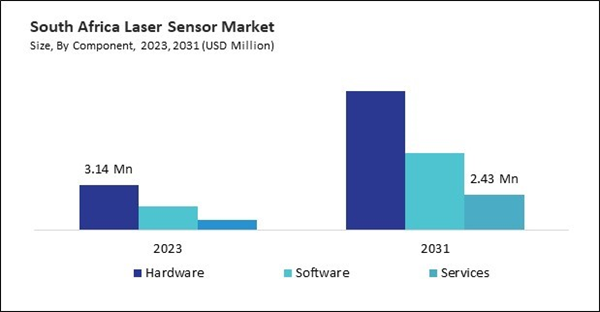The Brazil market dominated the LAMEA Laser Sensor Market by Country in 2023, and would continue to be a dominant market till 2031; thereby, achieving a market value of $38.8 million by 2031. The Argentina market is showcasing a CAGR of 16% during 2024-2031. Additionally, the UAE market would register a CAGR of 14.4% during 2024-2031.
The market expansion is bolstered by an increase in the production of consumer electronics. Smartphones and wearable devices, key drivers of the consumer electronics industry, have incorporated these sensors to enable more advanced functionality, such as motion tracking, distance measurement, and biometric authentication. A mobile phone is owned by 78% of the population aged 10 and older in 2023, which is 11 percentage points higher than the percentage of individuals who use the Internet, according to the International Telecommunication Union (ITU). This gap is shrinking in all regions, as growth in Internet use has significantly outpaced the growth of mobile phone ownership over the last three years.
Wearable devices, including smartwatches and fitness monitors, are increasingly utilizing these sensors for a variety of health-related applications in addition to smartphones. These sensors are indispensable for the development of immersive experiences in augmented reality (AR) and virtual reality (VR) by accurately detecting gestures and monitoring movements. As the AR and VR sectors grow, these sensors are becoming increasingly important for ensuring the accuracy and responsiveness of these technologies.
South Africa’s automotive sector has become a key area for the sensor adoption as the country continues to grow as an automotive manufacturing hub in Africa. With automakers like BMW, Volkswagen, and Ford maintaining production facilities in South Africa, these sensors are being integrated into assembly lines for welding, component alignment, and quality inspection tasks. In 2022, the South African automotive industry's broader contribution to the gross domestic product (GDP) was 4.9%, as reported by the International Trade Administration. This includes 2.9% manufacturing and 2% retail. The demand for these sensors in the country's automotive plants is driven by the increasing automation of production processes and the push toward more efficient manufacturing. This is due to the need to ensure precision and improve productivity. Thus, the demand for laser sensors in LAMEA is fueled by the modernization of industries across the region.
List of Key Companies Profiled
- Keyence Corporation
- Banner Engineering Corporation
- SICK AG
- Rockwell Automation, Inc.
- Omron Corporation
- Baumer Holding AG
- Panasonic Holdings Corporation
- Leuze electronic GmbH & Co. KG
- Schneider Electric SE
- Laser Technology, Inc.
Market Report Segmentation
By Component
- Hardware
- Software
- Services
By Type
- Laser Displacement Sensors
- Laser Photoelectric Sensors
- Laser Scanners
- Others
By Application
- Process Monitoring & Quality Control
- Distance Measurement
- Security & Surveillance
- Motion & Guidance
- Manufacturing Plant Management
- Others
By End-use
- Automotive
- Consumer Electronics
- Healthcare
- Aerospace & Defense
- Food & Beverages
- Chemical
- Others
By Country
- Brazil
- Argentina
- UAE
- Saudi Arabia
- South Africa
- Nigeria
- Rest of LAMEA
Table of Contents
Companies Mentioned
- Keyence Corporation
- Banner Engineering Corporation
- SICK AG
- Rockwell Automation, Inc.
- Omron Corporation
- Baumer Holding AG
- Panasonic Holdings Corporation
- Leuze electronic GmbH & Co. KG
- Schneider Electric SE
- Laser Technology, Inc.
Methodology

LOADING...









